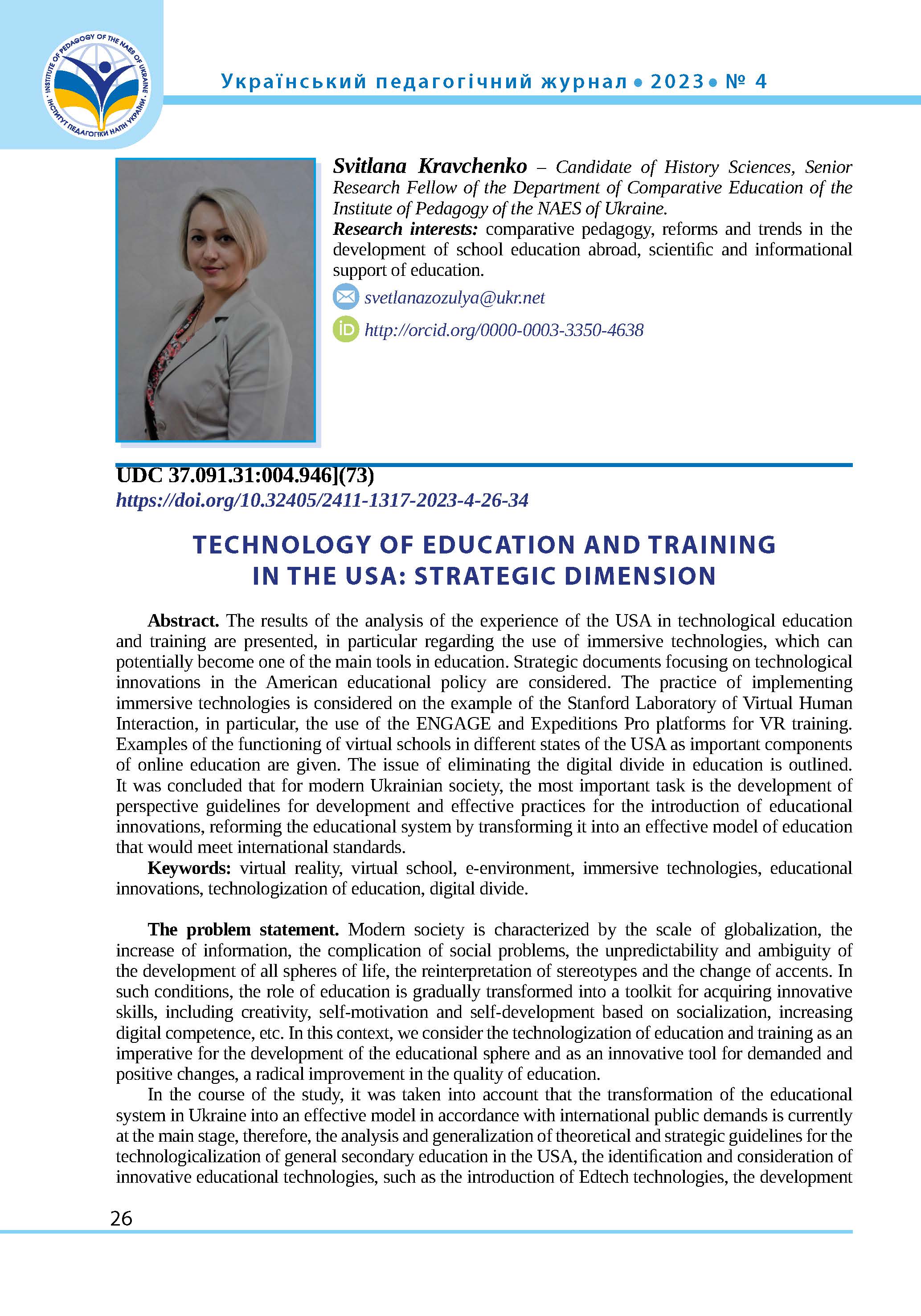Abstract
The results of the analysis of the experience of the USA in technological education and training are presented, in particular regarding the use of immersive technologies, which can potentially become one of the main tools in education. Strategic documents focusing on technological innovations in the American educational policy are considered. The practice of implementing immersive technologies is considered on the example of the Stanford Laboratory of Virtual Human Interaction, in particular, the use of the ENGAGE and Expeditions Pro platforms for VR training. Examples of the functioning of virtual schools in different states of the USA as important components of online education are given. The issue of eliminating the digital divide in education is outlined. It was concluded that for modern Ukrainian society, the most important task is the development of perspective guidelines for development and effective practices for the introduction of educational innovations, reforming the educational system by transforming it into an effective model of education that would meet international standards.
References
Digital Education Action Plan (2021‒2027). (2021). European Commission. Electronic Resource. https://education.ec.europa.eu/focus-topics/digital-education/action-plan
Incheon Declaration and Framework for Action for the implementation of Sustainable Development Goal 4. (2016). Electronic Resource, 83 p. https://uis.unesco.org/sites/default/files/documents/education-2030-incheon-framework-for-action-implementation-of-sdg4-2016-en_2.pdf
Vegas, E., Hess, F.M. (2022). Realizing the promise: How can education technology improve learning for all? Electronic Resource. https://www.brookings.edu/articles/realizing-the-promise-how-can-education-technology-improve-learning-for-all/
Digital Education Action Plan. (2021). European Commission. Electronic Resource. https://education.ec.europa.eu/focus-topics/digital-education/action-plan
Innovating Education and Educating for Innovation. The Power of Digital Technologies and Skills. (2016). Electronic Resource, OECD Publishing, Paris. 152 p. https://doi.org/10.1787/9789264265097-en
Hadhazy, A. (5 November, 2021). Stanford course allows students to learn about virtual reality while fully immersed in VR environments. Stanford News. Electronic Resource. https://news.stanford.edu/2021/11/05/new-class-among-first-taught-entirely-virtual-reality/
Sysoieva, S. (2021). Digitalization of Education: pedagogical priorities. Education: Modern Discourses, 4, 14–22. https://doi.org/10.37472/2617-3107-2021-4-02
Transforming our world: the 2030 Agenda for Sustainable Development. (2018). UNDP. Electronic Resource. https://www.undp.org/ukraine/publications/transforming-our-world-2030-agenda-sustainable-development?gclid=Cj0KCQiAuqKqBhDxARIsAFZELmJjSYqNWTKccPmi5wbBiXXEkEtAHO8_LaNSdd-AnDi6ZrXq-dJDck4aAsEYEALw_wcB
Virtual Human Interaction LAB. (2022). Integrating VR into Classrooms and Curricula. Electronic Resource. https://vhil.stanford.edu/projects/2020/classrooms-and-curricula
Stanford University. (n.d.). Virtual Human Interaction LAB. Official Site. https://vhil.stanford.edu/
Holovchenko, H.O. (2020). Mediaosvita u SShA i Kanadi: teoriia i praktyka. 464 p.
Imersyvni tekhnolohii. (2020). Vikipediia. Electronic Resource. https://uk.wikipedia.org/wiki/%D0%86%D0%BC%D0%B5%D1%80%D1%81%D0%B8%D0%B2%D0%BD%D1%96_%D1%82%D0%B5%D1%85%D0%BD%D0%BE%D0%BB%D0%BE%D0%B3%D1%96%D1%97
Kravchenko, S.M. (2020). Osvita ta navchannia v konteksti pandemii COVID-19. 76 p. https://doi.org/10.32405/978-966-97763-3-0-2020-76
Kravchenko, S.M. (2021a). Tekhnolohizatsiia osvity i navchannia yak instrument onovlennia osvitnoho prostoru v krainakh pivnichnoamerykanskoho rehionu. Pedahohichna komparatyvistyka i mizhnarodna osvita 2021, 170–171. https://lib.iitta.gov.ua/727365/
Kravchenko, S.M. (2021b). Virtualni shkoly yak innovatsiinyi trend tekhnolohizatsii osvity i navchannia u SShA. Aktualni pytannia teorii ta praktyky v haluzi prava, osvity, sotsialnykh ta povedinkovykh nauk – 2021. 36‒38. https://lib.iitta.gov.ua/725139/
Kravchenko, S.M. (2022). Innovatsiia yak trend rozvytku zahalnoi serednoi osvity: dosvid USA. Osvitnia analityka Ukrainy, 1, 113–124. https://doi.org/10.32987/2617-8532-2022-1-113-124
Kremen, V.H., Liashenko, O.I., & Lokshyna, O.I. (2020). Zahalna serednia osvita Ukrainy v konteksti osvity krain Yevropy: tryvalist i struktura. 56 p. https://doi.org/10.32405/978-966-644-555-4-2020-49
Lokshyna, O., Hlushko, O., Dzhurylo, A., Kravchenko, S., Maksymenko, O., Nikolska, N., & Shparyk, O. (2022). Osvita v realiiakh viiny: oriientyry mizhnarodnoi spilnoty. 66 p. https://doi.org/10.32405/978-966-644-614-8-2022-55
Lokshyna, O.I., Hlushko, O.Z., Dzhurylo, A. P., Kravchenko, S.M., Nikolska, N.V., Tymenko, M.M., & Shparyk, O.M. (2020). Vidpovid svitovoi spilnoty na vyklyky COVID-19 v osviti (liutyi – cherven 2020). 36 p. https://doi.org/10.32405/978-966-97763-0-4-2020-36
Topuzov, O.M., & Holovko, M.V. (2021). Dystantsiine navchannia v umovakh karantynu: dosvid ta perspektyvy. 192 p. https://doi.org/10.32405/978-966-644-596-7-2021-192
Dzhurylo, A. (2021). On the impact of the COVID-19 pandemic on the assessment of the quality of education in the context of distance learning. Current issues of theory and practice in the field of law, education, social and behavioral sciences – 2021. 57‒60. https://lib.iitta.gov.ua/725393/
Chandra, S., Hill, H., Kothari, T., McBride, L., & Vaduganathan, N. (2021). Closing the Digital Divide in US Education – for Good. Related expertise: Education, K–12 Education. https://www.bcg.com/publications/2021/digital-access-in-united-states-education

This work is licensed under a Creative Commons Attribution-NonCommercial-ShareAlike 4.0 International License.


